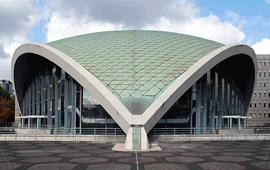> [Archived] Chronicles

Travel Notes... Musical Travel Notes - Dortmund, Oldenburg and back (I)
Dortmund - 20th, 21st February
The general rehearsals of W.A. Mozart's The Marriage of Figaro, the ninth of the fifteen opera, operetta and ballet premieres which make up the repertoire of this season, are taking place at the Opera. There are two understudies for each protagonist excepting the couple Count and Countess Almaviva. The soloists, most youngsters with good voices, seem to know exactly what they are doing, even if not all of them succeed all the time. It was a great pleasure to discover that the very young mezzosoprano Ileana Mateescu is part of the premiere's cast. Maria Slătinaru's former student who studied at Mozarteum - Salzburg is assigned the role of Cherubino with optimum vocal orientation and irresistible acting charm.
Under the baton of Jac van Steen, the progress from one rehearsal to another seems impressive, especially regarding the coordination between the pit and the stage. Dortmund Philharmonic Orchestra - which also boasts a permanent symphonic season, besides the concerts at the Opera - is similar to a fitted and well-kept mechanism whose performance is at its best if it is operated properly.
The mise-en-scène is just breathtaking and it is a co-production of Nuremberg State Theatre. The director Mariame Clément's view joints the best meanings of what modern entails; her view is ingeniously put forward and the minimalistic means are also present. Whilst the costumes and props are anchored in the historical period of the subject, the sequence of the frames, the characters' highlighting and their interaction are expressed through unconventional artifice. The stage represents Count Almaviva's residence, quite a close copy of all its rooms and outhouses. It is only in the second act when walls are used to illustrate the Countess's chamber. Otherwise, a significant piece of furniture depicts a particular room and the role and status of its characters. For instance, once the curtain is pulled, in the first act the Countess' bed is a hint for doctor Bortolo's visit that has come to see and write her a prescription although she is not actually present in the score; a piano depicts the "music chamber" and having Don Basilio playing it, of course; a buffet, a kitchen table, a laundry rope delimit the servants area. The stage teems with characters fidgeting; there is a silent animation of black figures on a bright background, as one could find in Mozart's time engravings. There is a permanent switch of positions like in a swing through light and shade which is meant to bring forth the protagonists' weight. Their figures become poignant, full of colourful shapes that are now endowed with voice. Whilst this swing is constant, the few props are gradually diminishing or they just fade away completely, leaving the audience to make use of their fantasy. The four acts are joined two by two outlining a fluent, natural and witty plot.
There will be an outstanding premiere.
22nd Feburary
I also saw Der Traum der roten Kammer - Dream of the Red Chamber, a ballet performance based on the contemporary British composer Michael Nyman, a modular, minimal music, with lots of repetitions that preponderantly is described as chamber music - there are a lot of interesting instrumental violin, flute and piano solos strewn with a few exquisite tutti sound culminations. The conductor was the Japanese Motonori Kobayashi- a full- time conductor at Dortmund Opera-who joined stage with the Romanian ballerina Monica Fotescu- as female protagonist- who looked slimmer and more delicate than ever. Although there are ten years since she has been working as a ballerina here, lately, her performances here and in Romania as well, had made her famous. Christian Baier's script for the Dream of the Red Chamber is based on the Chinese cultural and historical tradition since the era of multiple kingdoms until nowadays.
The beauty of costumes, the eloquence of props replenished in some key points with a few fitted projections have multiplied the music and the dance impact on the audience, bringing about the "local colour" that nor the compositional script, neither the choreography succeeded to emphasise. The latter is the outcome of the Chinese choreographer Xin Peng Wang who has been working here for almost a decade. Under his leads, the Dortmund Ballet has achieved a privileged position, a managerial autonomy from other departments of the Theatre, quickly becoming the audience's favourite.
The ballet performances are sold out; tickets are sold with months in advance.
The Dream of the Red Chamber was also held with a full-house.
Translated by Sorina Cimpoeru and Elena Daniela Radu
MTTLC, Bucharest University














